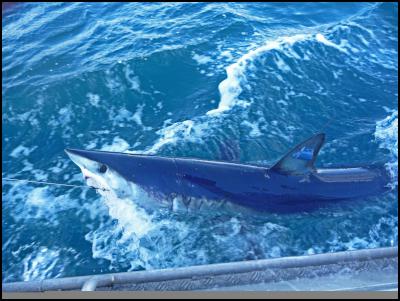A mako shark named Carol
A mako shark named Carol

Carol the mako shark
Photo credit Scott Tindale
The mako shark is fast and fascinating. The shortfin mako, Isurus oxyrinchus, has been recorded swimming at speeds of about 100km/h. It’s the fastest of the world’s shark species. Mako sharks are found in waters right around New Zealand. Only occasionally are they found close inshore.
There are two species of Mako shark, the long fin and the short fin, but only the shortfin is found in New Zealand.
NIWA Principal Scientist Dr Malcolm Francis says, “Mako is its Māori name, meaning either the shark or a shark tooth. The Māori name has been adopted worldwide, though it is often mispronounced ‘may-ko’ rather than the more correct ‘mar-kor’. Other rarely-used names for shortfin mako are mackerel shark and blue pointer.”
The shortfin mako is long and slender, with a relatively long pointed snout. It has small eyes. Its pointed teeth protrude from the mouth, but are smooth edged and extremely sharp.
It has short pectoral fins, a tiny second dorsal and anal fin, a crescent-shaped caudal fin, and indigo-blue dorsal surfaces and white undersides. It’s muscular and powerful. Mako can weigh up to half a tonne.
They leap out of the water, and are fast and agile when attacking prey or lures, making them a daunting animal to confront in the wild. Rarely, they have been known to attack humans. Fortunately, you are highly unlikely to come face to face with a mako this summer. They are oceanic rather than coastal, although they occasionally enter coastal waters, and occur anywhere from the sea surface to 650 metres deep.
Their diet consists mainly of schooling fish and squid.
At full maturity, male mako sharks are about 200cm long and females 300310cm. Males mature at 8 years and females at 20 years.
Mako sharks are targeted for their highly-prized fins and their good-quality flesh. The species is listed as “vulnerable” on the International Union for Conservation of Nature list of threatened species.
Most of the commercial catch of mako sharks is taken by tuna longliners and most of the catch is processed.
There has been only limited research on mako sharks and there is general uncertainty about the state of the stocks. New Zealand mako shark fisheries are managed under a quota system which limits the amount of sharks caught. Current catches are well below the quota.
The New Zealand National Institute of Water and Atmospheric Research (NIWA) is conducting research on mako sharks, funded by the Ministry for Primary Industries. Tagging mako sharks will help identify the geographical range of New Zealand sharks, and how they mix with makos from other parts of the Pacific Ocean. This information is important for determining mako stock structure, which is fundamental for assessing stock status. Tagging will also help determine how long makos remain in New Zealand waters, and whether they make regular seasonal migrations. This tagging study is being carried out in collaboration with Dr Mahmood Shivji at the Guy Harvey Research Institute (GHRI) at Nova Southeastern University in Florida, who are funding the electronic tags and Argos satellite time.
“Conventional plastic identification tags tell us little about the timing of mako shark movements, the route that they take or distance travelled,” says Dr Francis, who is leading the NIWA research.
The scientists have been tracking Carol, a 1.8m mako, using a satellite reporting tagging device known as a SPOT tag. This was attached to Carol in the Bay of Islands six months ago and is providing scientists with remarkable and previously unknown details of the timing and long-distance migratory movements of this species.
The SPOT tag is revealing that Carol is spending a lot of time at the ocean’s surface, reporting her location to the satellite several times daily.
So far, Carol has travelled over 13,300km in seven months, averaging 60km per day and exceeding 100km per day during some parts of her migration. She has been to Fiji and back to New Zealand and has worked her way past the Bay of Plenty and Hawke Bay heading south. She was last heard from heading down the east coast of the South Island past Kaikoura Peninsula.
To follow Carol’s
travels on a GHRI interactive website go to:
http://www.nova.edu/~johnmatt/makosharks.htm
Based on the amazing results from this initial trial, the GHRI and NIWA are expanding their mako migration study by tagging more makos off east Northland in February 2013.
ENDS


 NIWA: Ship Anchors May Cause Extensive And Long-lasting Damage To The Seafloor, According To New Research
NIWA: Ship Anchors May Cause Extensive And Long-lasting Damage To The Seafloor, According To New Research New Zealand Customs Service: A Step Forward For Simpler Trade Between New Zealand And Singapore
New Zealand Customs Service: A Step Forward For Simpler Trade Between New Zealand And Singapore Horizon Research: 68% Say Make Banks Offer Fraud Protection
Horizon Research: 68% Say Make Banks Offer Fraud Protection NZ Banking Association: Banks Seek Government Support For Anti-Scam Centre
NZ Banking Association: Banks Seek Government Support For Anti-Scam Centre National Road Carriers: Praises NZTA State Highway Investment Proposal Turnaround
National Road Carriers: Praises NZTA State Highway Investment Proposal Turnaround Greenpeace: Cameras Reveal Mass Underreporting Of Dolphin, Albatross And Fish Bycatch By Commercial Fishing Industry
Greenpeace: Cameras Reveal Mass Underreporting Of Dolphin, Albatross And Fish Bycatch By Commercial Fishing Industry



